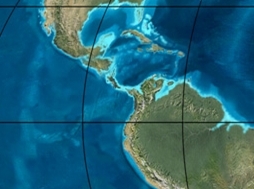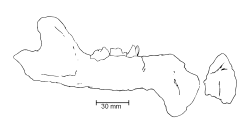| Honda Group | |
|---|---|
| Stratigraphic range: Late Oligocene-Late Miocene typically Middle Miocene (Laventan) ~ | |
 Statue of a prehistoric ground sloth from the Honda Group in Villavieja, Huila | |
| Type | Geological group |
| Sub-units | Villavieja Formation Cerro Colorado Mb. Baraya Mb. La Victoria Fm. Cerbatana Mb. |
| Underlies | Gigante Group Neiva Fm. |
| Overlies | Payandé Group Barzalosa Fm., Saldaña Fm., Santa Teresa Fm. |
| Thickness | up to 5,000 m (16,000 ft) |
| Lithology | |
| Primary | Conglomerate, sandstone |
| Other | Claystone, siltstone, volcanoclastic sediments |
| Location | |
| Coordinates | 5°11′31″N74°43′21″W / 5.19194°N 74.72250°W |
| Region | Huila, Tolima, Cundinamarca Middle Magdalena Valley, Upper Magdalena Valley Central & Eastern Ranges Andes |
| Country | Colombia |
| Extent | ~250 km (160 mi) |
| Type section | |
| Named for | Honda |
| Named by | Hettner |
| Location | Honda (original) Tatacoa Desert (redefined) |
| Year defined | 1892 |
| Coordinates | 3°14′04″N75°12′15″W / 3.23444°N 75.20417°W |
| Approximate paleocoordinates | 3°06′N72°24′W / 3.1°N 72.4°W |
| Region | Tolima (original) Huila (redefined) |
| Country | Colombia |
| Thickness at type section | 3,255 m (10,679 ft) |
 Paleogeography of Northern South America 20 Ma, by Ron Blakey | |
The Honda Group (Spanish : Grupo Honda, Tsh, Ngh) is a geological group of the Upper and Middle Magdalena Basins and the adjacent Central and Eastern Ranges of the Colombian Andes. The group, in older literature also defined as formation, is in its present-day type section in the Tatacoa Desert in the department of Huila subdivided into two main formations; La Victoria and Villavieja.
Contents
- Etymology and definitions
- Regional setting
- Description
- Stratigraphy
- Age
- Depositional environment
- Petroleum geology
- Fossil content
- Mammals
- Birds
- Reptiles and amphibians
- Fish and crustaceans
- Panorama
- Regional correlations
- Laventan correlations
- See also
- Sources
- Notes
- References
- Bibliography
- See also 2
- Notes 2
- References 2
- Bibliography 2
- External links
The group was originally defined in and named after Honda, Tolima, but has been redefined based on the many fossil finds in the Tatacoa Desert, 250 kilometres (160 mi) to the south. In the original type section of its occurrence, the 3,255 metres (10,679 ft) thick group is subdivided into three formations, from old to young; Cambrás, San Antonio and Los Limones.
The group dates to the Neogene period; in its broadest definition from the Late Oligocene to Late Miocene, and in the redefined type section restricted to the Laventan age of the South American Land Mammal Ages (SALMA), equivalent to the Middle Miocene Serravallian epoch.
The Honda Group is a Konzentrat-Lagerstätte at the fossiliferous La Venta site in the department of Huila and eastern Tolima and hosts one of the richest formations containing Miocene fauna worldwide.






















































